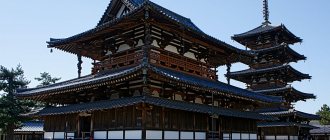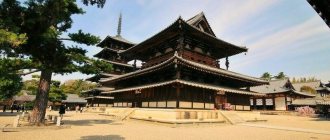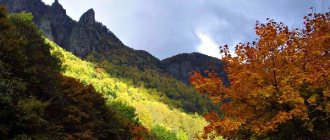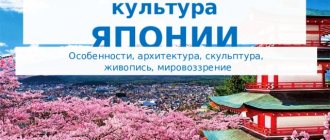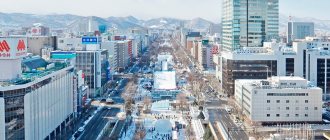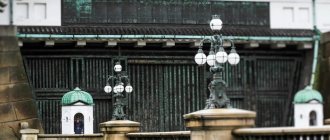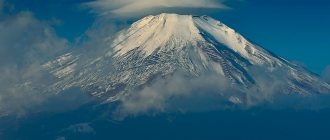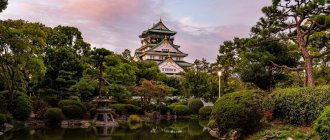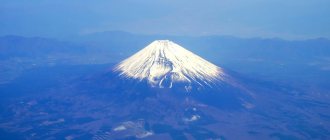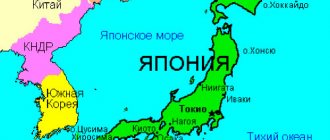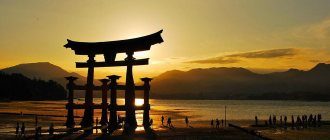Not far from Osaka in the Wakayama region rises the majestic and mighty Japanese mountain - Koya-san. To get to the place, tourists have to overcome a dangerous path along a two-way mountain serpentine.
But once they reach the place, tourists will be able to feel the peace and quiet of this sacred mountain. The purest air and complete serenity await tourists in this mysterious place. Koya-san is like a restless traveler, lost in the middle of impenetrable mountain forests.
At the very top of Koyasan there are a huge number of holy temples dedicated to the great Buddha.
The Legend of the Mighty Koya-san
Many thousands of years ago (774), an ordinary boy named Kukai was born on the small Japanese island of Shikoku. When he grew up, he wanted to devote himself to serving the Buddha. For this he decided to become a monk. Kukai was a very educated boy. He studied in China for a long time and was the best student of his spiritual teacher.
After graduating from theological school, Kukai traveled and wandered around the world for a long time and finally decided to build a sacred temple in his homeland. He wanted it to be a quiet, cozy corner where serenity and tranquility would reign. To find such a corner, Kukai sent a vajra with birds. He hoped that she would show him the place that he had been looking for for so long.
One day Kukai met a giant hunter. He held a bow and arrows in his hands. The hunter told Kukai that he knew where the place he was looking for was. The hunter gave him two dogs, which led the monk to the mighty mountains. Here he met an elderly woman who pointed Kukai to a path leading up the slope. At the very top of the mountain, the monk saw a mighty old cedar. He carefully examined the tree and found that same vajra in its branches. This is how the first monasteries and temples appeared on Mount Koya-san.
Koya-san, Mountain of the Great Teacher
Koya-san is called the Mountain of a Thousand Temples. But time and the course of history have left a little more than a hundred of them here. The Buddhist complex has seen years of ups and downs. The troops of the commander Nobunaga Oda, who by force sought to unite the country mired in civil strife, at the end of the 16th century. More than one hundred believers were slaughtered here. But under the Tokugawa shoguns, the Kongobu-ji monastery received state support. The first monastery here was founded in 819 by the founder of the Shingon school, monk Kukai (774-835), preacher, poet and philosopher. He considered the Koya mountain plateau as Taizokai (the cycle of the womb of the mandala), and the eight mountains rising above the plateau as the eight petals of a lotus - a symbol of the cosmic Buddha Vairocana.
Shikoku Kukai, in his youth, decided to become a Buddhist monk, studied in China, returned to Japan, he spread his teachings in Nara and Kyoto and won the respect and trust of the emperor. He liked the place in the vicinity of Mount Koya for its solitude, and a local hunter suggested it, giving Kukai his dogs, white and black, to accompany him. Dogs are considered sacred in these places even today. The pilgrims' route to the top of the mountain starts from a small women's temple at the foot of Koi-san, Jison'in , and ends at Kukai's mausoleum on the eastern peak of the mountain.
His followers claim that Kobo Daishi ("Great Teacher", "distributor of Dharma") did not die. At the age of 61, Kukai plunged into meditation, refused food and water and after 21 days entered deep samadhi, and now awaits the coming of the Buddha. This spiritual practice, known as the Sokushinbutsu ritual, has spread to many countries professing Buddhism. Kobo Daishi opened public schools, built dams, and invented the Japanese syllabary. He is recognized as a bodhisattva who came to the aid of people during the period of decline between the Buddhas Shakyamuni and Maitreya.
Also interesting: Belur and Halebid, the architectural treasures of Karnataka
Why is Koya-san so attractive to tourists?
A magnificent sight awaits tourists who arrive in this oasis of silence and tranquility. A mighty, inaccessible mountain covered with dense vegetation rises proudly in the midst of dense impenetrable forests. The air is so clean and fresh that you can feel dizzy. And the silence is such that you can even hear your heartbeat.
At the very top of the mountain there are a huge number of Buddhist monasteries and temples. Among them are Okuno-in, Kongobu-ji and Kopon-daito. Pilgrims and tourists from all over the world come here to admire this splendor.
— The central temple of Koya-san, Kongobu-ji, attracts special attention from tourists. This is a low wooden building made in oriental style. The roof has curved edges characteristic of Japanese buildings. In some places the temple is surrounded by a small fence.
Kongobu-ji consists of numerous spacious pavilions and ancient pagodas. Inside the temple, tourists can see a large number of spacious, bright rooms. The walls of these rooms are decorated with various national paintings, as well as small canvases with legends and drawings about the founder of the temple, monk Kukai. Magnificent meditation halls are scattered throughout Kongobu-ji. All of them are decorated with numerous paintings. The Kongobu-ji complex also includes a large library and the mausoleum of Dento Kokushi.
On the territory of the temple, tourists can visit a magnificent rock garden. Here they will be able to admire perennial wild maples with unusually beautiful leaves of bright crimson-red color. There are numerous gray stones scattered throughout the garden. And in the center of the garden there is a small picturesque pond with water lilies and lilies.
— The next point of the excursion is the no less beautiful Okuno-in Temple. This is a small wooden Buddhist temple dedicated to the monk Kukai. Kukai's mausoleum and his tomb are located on its territory.
In order to get to the temple, tourists must cross a long carved bridge. The bridge was built in medieval style.
Not far from the temple there is a religious cemetery. They love to welcome guests in this temple. Pilgrims from all over the world find their refuge here.
— Next, the excursion goes to the Kompon-daito temple. It is made in the original ancient Japanese style. This is a red two-story building with a beautiful carved roof. Inside the temple, tourists will be able to see a large number of figurines and monuments of Japanese gods.
— Another remarkable place in Koya-san is the famous Japanese museum - Reihokan. It contains a huge collection of unique treasures of Japan. These are a variety of statues, numerous monuments, unique paintings and other rare exhibits.
You can get to the mountain by train from Namba Station, located in Osakada. The high-speed train will transport tourists in just five minutes.
Accommodation and rules of Koya-san
Tourists and pilgrims can stay in the city of Koya-San, which has grown around the temples. The place to stay for the night can be called a ryokan, but guests will be staying in the temple, since there are no other buildings in the city. You can book accommodation in advance via the Internet. Koi-san has a couple of small shops and stalls to buy food and souvenirs.
New arrivals will be asked to leave their shoes outside before entering the temple and will be given slippers, a yukata and instructions on how to behave on the premises.
Sohonzan Kongobuji Temple
Sometimes the entire Mount Koyasan is called “Kongobuji Temple,” but for the purposes of this material we will mean by this name the building of the Seiganji and Kozanji Temple.
Seiganji was built in 1593 by Toyotomi Hideyoshi in memory of his mother.
To get to the Kongobuji Temple grounds, you need to go through the Sanmon Gate. Here you can see:
- one of the largest rock gardens in Japan, called Banryu-tei;
- Yanagi-no-ma is the place where Toyotomi Hidetsugu, the son of Toyotomi Hideyoshi, committed suicide;
- Ohiroma with drawings on sliding doors by Kato Motonobu, an artist of the Muromachi period (1336-1573);
- Shin-Betsuden, which was added during the Showa period (1926-1989). Nowadays, Shin Betsuden is used as a tourist destination, serving tea and sweets.
A unique feature of Kongobuji Temple is the presence of a tensuoke (rainwater collection tank) on the roof, which is covered with Japanese cypress bark. In the event of a fire, rainwater from the tensuoke is sprayed onto the fire to extinguish the flames.
You can stay for a while at the Mount Koyasan Temple premises. It is worth noting the fact that each of the temples of the complex has a unique history and appearance, as well as a special garden. Alcoholic drinks such as beer and sake, called hanyato, can be purchased on temple premises if desired. Young monks who practice asceticism in the temple will bring you food, set the table for you, and also prepare your bed. This way you can try vegetarian food called shojin-ryori, which is eaten by the monks of the temples themselves. In addition, you will have the opportunity to take part in a religious service that takes place early in the morning.
Holidays in Japan: Koya
Wakayama Prefecture belongs to the areas of the most ancient settlement of the Japanese islands. The warm Kuroshio Current, which in these places comes very close to the coast of Honshu, not only provides a mild, fertile climate, but also supplies the inhabitants with an abundance of fish, edible seaweed and shellfish. The Japanese willingly settled on the narrow coastal strip of the Kii Peninsula, mastering rice growing and fishing, growing vegetables and surprisingly sweet tangerines. However, already a few hundred meters from the seashore, high cliffs rose, gradually forming a mountainous country. Although these places are located in close proximity to the old Japanese capitals - Nara and Kyoto - they were considered a remote province. And if anyone was interested in the inaccessible gorges of the Kii mountain ranges, then it was only Buddhist monks who were looking for shelter here for religious service.
One of these religious strongholds was Mount Koyasan. Located in the heart of the Kii Peninsula, with thickets of black cedar trees at an altitude of 900 meters, Mount Koyasan is the site most revered by the Kingon Buddhist sect. Legend claims that in 816, the Buddhist preacher Kukai (Kukai, 744-835), somehow waking up after a prayer trance, saw in front of him a hunter with two dogs - white and black. The monk perceived the hunter as a forest god, materialized in response to an urgent prayer for a place from above for a sacred shelter. And indeed, the hunter took Kukai high into the mountains, where he showed him a narrow valley suitable for building a monastery. Actually, Kukai was not the first seeker of religious truth in these places. And before him, Buddhist monks tortured themselves here with asceticism in the hope of enlightenment. But Kukai had shortly before received permission from the emperor to found a religious community of the Buddhist sect Shingon in these mountains.
During the years of monasticism, Kukai wandered around the country a lot, converting local residents to his faith. His name is associated with the founding of many temples and monasteries, the construction of artificial reservoirs in the arid regions of the island of Shikoku and the invention of “kana” - the national alphabet, which allowed the Japanese to simplify their writing, which was formed under the influence of Chinese hieroglyphs. Kukai also received recognition as a poet, sculptor, and calligrapher. He was welcome everywhere. But it was Mount Koya-san that the famous preacher considered his real home. In the valley chosen by Kukai, over time, an entire religious complex grew up, consisting of many temples and monasteries. This entire community was called Kongobuji, but in 1869 this name was assigned to the head, largest temple on Koya-san.
The Buddhist complex has seen years of ups and downs. The troops of the commander Nobunaga Oda, who by force sought to unite the country mired in civil strife, massacred more than one hundred believers here at the end of the 16th century. Oda’s follower, the military leader Hideyoshi Toyotomi, was also planning a military campaign here. But under the Tokugawa shoguns, the Kongobuji monastery received government support. At the beginning of the 17th century, here, on an area of 100 hectares, there were more than a thousand temples and other religious buildings (now about 120 of them have survived). Since 1872, the ban on visiting these holy places for women was lifted. And now the number of pilgrims who annually go on pilgrimage to Mount Koya-san is in the millions.
You can get here by train to Gokurakubashi Station or by bus. From the stop a cable car rises to the mountains. After leaving her trailer, the visitor finds himself in front of the Nyonindo building. When women were not allowed into the monastery grounds, they could stay in this building and offer prayers while looking at the sacred valley spread out at their feet. From Nyonindo the road goes smoothly down to the village of Koya. On both sides of the road, small temple buildings can be seen through the palisade of umbrella pine trunks (koyamaki). At the foot of the hill is the Haryoin building - a kind of hotel for pilgrims. It even built a children's playground with a two-tier pagoda.
The Giant Great Gate - Daimone is the main entrance to Koya-san, located on the edge of the plateau. They offer unique views of mountains, valleys, and, on clear days, the distant islands of Shikoku and Awaji. The most revered and grandiose buildings are located in the western part of Koya-san.
The Reihokan Museum will introduce you to the religious treasures of the Koya-san complex. There is a whole collection of ink paintings (sumie) depicting famous Buddhist preachers of the Kamakura period (1185-1333) surrounded by eagles and wild animals. Noteworthy is the picturesque scene of the Buddha's transition to nirvana, accompanied by crying disciples and animals. There is also a selection of paintings reflecting various stages of the life of the preacher Kukai, calligraphic scrolls with sutra texts, other objects of religious worship - mandalas, bronze sculptures of saints of the Buddhist pantheon. The museum also contains items more related to secular life - letters from the commanders Yoritomo Minamoto and his younger brother Yoshitsune, who fell victim to betrayal by Yoritomo.
During the Edo period, there were almost a thousand temples on the mountain, but typhoons and fires reduced their number to 120. The unique atmosphere of this place can be fully experienced if you stay at least one night. Traditional vegetarian cuisine is served on Koya-san at 53 temple shelters.
The sacred Buddhist center on Mount Koyasan is not the only religious sanctuary in Wakayama. Since ancient times, the Japanese believed that the mountainous area of Kumano (Kumano - Bear Field), facing the ocean, was chosen by the kami gods for their habitat. Located quite close to the main Shinto shrine Ise Jingu, dedicated to the sun goddess Amaterasu, the Kumano Plain became a place of worship of her divine brother and in some sense rival, the god of wind, water and disease Susanoo no Mikoto.
